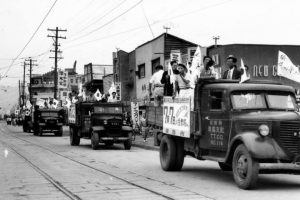Striving to fill voids in Hiroshima, Chugoku Shimbun and the press code — Surveillance of articles with A-bombing content, Part 8: Peace Memorial City Construction Law and the GHQ
Sep. 29, 2023
Censorship eased after law’s enactment
At the beginning of 1948, moves began in earnest to reconstruct Hiroshima, the city left devastated by the atomic bombing, and an increasing number of articles covering that activity were starting to appear in the Chugoku Shimbun.
Financial support from the national government was essential for the city’s costly reconstruction projects. Hiroshima City repeatedly requested government funding but never received a favorable response. With so many other cities throughout the country damaged by U.S. air raids, special treatment for only Hiroshima was untenable. Moreover, would the occupation policy of the General Headquarters of the Allied Forces (GHQ), led by the United States, the country that dropped the bombs, have allowed special treatment for Hiroshima?
Symbol of achieving ideal
Hiroshima City officials and others sought a way out through enactment of a new law that would financially support the city’s reconstruction. To succeed, the new law would need to have a philosophy of city planning that went beyond mere recovery.
In February 1949, a member of Japan’s Diet representing Hiroshima and Tsukasa Nitoguri, chair of the Hiroshima City Council, requested someone in the legal profession to draft a law. Tadashi Teramitsu, a native of Hiroshima who was familiar with Diet proceedings and knowledgeable about the law, was then director general of the Proceedings Department of the House of Councilors (upper house of the Diet). His focus fell on the phrase “peace for all time,” which had been incorporated into Japan’s new constitution.
The draft prepared by Mr. Teramitsu consisted of seven articles. Article 1 put forth development of a city that would serve as a symbol of world peace with the language, “It shall be the object of the present law to provide for the constitution of the city of Hiroshima as a peace memorial city to symbolize the human ideal of sincere pursuit of genuine and lasting peace.”
Their efforts prompted action by the GHQ and the prime minister of Japan. On May 11, 1949, the special law known as the Hiroshima Peace Memorial City Construction Law, was passed by the Diet. On July 7, the law was put to a local referendum, the first in Japan, and on August 6, four years after the atomic bombing, it was promulgated based on approval from around 91 percent of the voters.
The Chugoku Shimbun covered details of how the law was established. When the newspaper investigated the status of article censorship, an interesting trend emerged — the application of censorship clearly differed before and after the law was enacted in May.
On February 9, 1949, the newspaper was found to have reported that Shinso Hamai, mayor of Hiroshima at the time, had traveled to Tokyo to request help. With that, we investigated the censorship status of relevant articles carried in the paper over a period of about four months from that date, when the full-fledged campaign to request funding began, through June 19, the date the last relevant article was published after the law had been enacted.
During that period, most articles, 67, underwent censorship, and only six did not, with seven being unclear one way or the other.
On the other hand, for a period of less than a month, from June 20, when the focus had shifted to the local referendum, to July 13, the date of publication of the paper with the last of such reports, the trend was exactly the opposite — only seven were censored, while 50 were not, with three being unclear.
MacArthur's “approval” in background
The shadow of censorship faded after the law had gone into effect. What happened? The newspaper was not able to find a definitive answer from the remaining GHQ materials. However, one factor in the background was the “approval” of Douglas MacArthur, Supreme Commander for the Allied Powers.
In February 1949, Mr. Nitoguri met with Mr. MacArthur. The meeting was successfully arranged by a high-ranking GHQ official who had visited Mr. Nitoguri two months earlier to seek cooperation in the issue of finding a site for the Atomic Bomb Casualty Commission (ABCC), and in return Mr. Nitoguri had strongly requested support for the city’s reconstruction.
When Mr. Nitoguri asked for help while explaining the philosophy of the proposed bill, Mr. MacArthur is said to have simply told him that it was a good idea and that he should work hard to move it forward.
Mr. MacArthur’s support certainly played a big role in the realization of the Hiroshima Peace Memorial City Construction Law, which served as the foundation for Hiroshima’s postwar recovery. That situation was also likely not entirely unrelated to the easing of censorship of the reporting on the issue.
(Originally published on September 29, 2023)








